In separate posts, I’ve explained the names of steerer parts and how to measure the important dimensions. This post deals with headset bearings standards. If you’re (re)packing a (new) headset with loose bearing balls, see: Standard bicycle bearing ball sizes.
TL/DR
Buying new headset bearings can be overwhelming. I wrote this article to help you figure out what dimension you need.
Don’t be scared – take your time, measure everything as I’ve explained, and you’ll be good. The table of contents should help you navigate and “skip” to the parts you need.
My Forks & Headsets article series:
- Bicycle fork models and brake mounts
- Headsets [01] Names of fork and headset parts
- Headsets [02] Important fork, head tube and headset dimensions
- Headsets [03] Headset bearings standards – SHIS
1. Introduction
During the years, especially from the beginning of the 21st century, there has been a great number of different headset bearing types introduced. This has created a lot of confusion in practice. Apart from a number of various different types and dimensions, some manufacturers coined their own names for headsets that were practically identical to such (different named) headsets of other manufacturers. To eliminate the confusion, a group of manufacturers publishes SHIS (Standardized Headset Identification System) nomenclature. SHIS is not a headset standard, but a set of rules for describing headset dimensions. Many manufacturers and distributors are adopting this nomenclature. Two headsets with the same SHIS mark are compatible (interchangeable), regardless of market name and manufacturer.
When marking headset bearings, it is important to remember that top and bottom bearing dimensions can differ (depending on fork and head tube type). Apart from remembering uniform and tapered width forks, it is also important to remember the three types of headset bearings: external (EC), integrated (IS) and internal (ZS).
2. Marking rules (format)
A typical SHIS mark looks like this (what it means will be explained in this post, this is just an introduction):
ZS44-24tpi/28.6 | ZS44/30 – headset for a threaded fork
ZS44/28,6 | EC49/40 – headset for a threadless tapered fork
Notation format is the following:
upper_stack | lower_stack
Vertical line (” | “) divides top (upper) and bottom (lower) bearing stack marks.
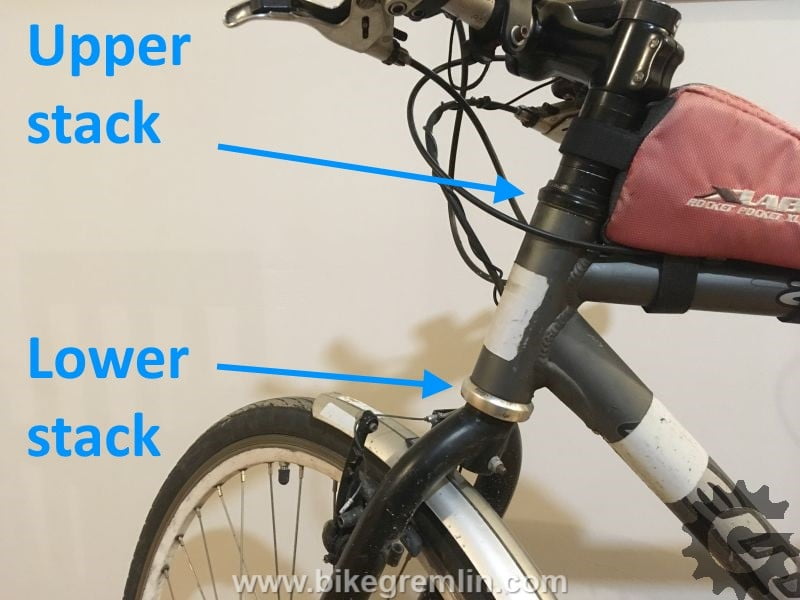
Picture 1
Marks for both top and bottom stack are written using the following format:
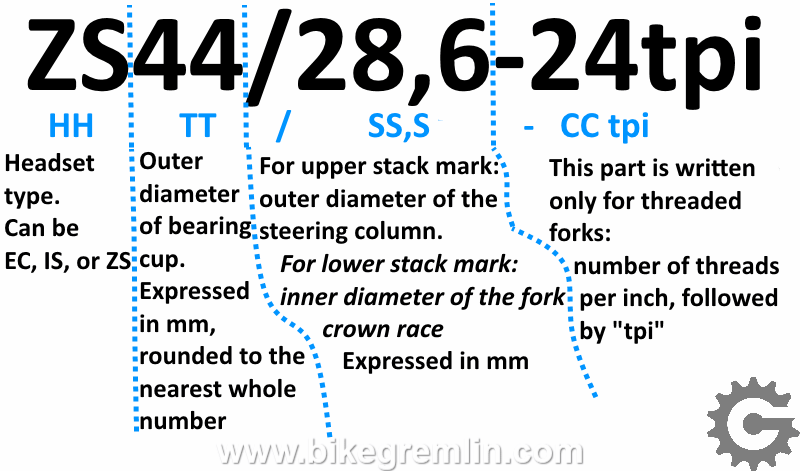
Picture 2
Explanation of marks:
HH: bearing type – EC-external, IS-integrated and ZS for internal type.
TT: approximate measure in mm of the outer diameter of bearing cup and inner diameter of head tube bearing bore.
/SS,S: this label marks different things, depending on whether it is used for upper, or lower stack bearings. For upper stack bearings it notes the outer diameter of the fork steering column. For lower stack bearings, it presents an approximate inner diameter of the fork crown race as well as the approximate outer diameter of the fork crown.
-CCtpi: number of threads per inch for threaded forks. For threadless forks this mark is omitted.
It is not noted in picture 2, for simplicity reasons (and since it’s not often used), but manufacturers can also note how much a bearing stack sits above/below the head tube. This is expressed by a letter “H“, followed by the stack “height” in millimetres. Given separately for upper and/or lower bearing stack.
Important note:
For integrated (IS) headsets, the current standard of 45 degree bearing angle is assumed, so the bearing angle is not indicated by SHIS nomenclature.
3. Standard dimensions
Overview of the standard dimensions will be given by mark type. First for the head tube bore inner diameter (TT), then for the upper stack i.e. steering column diameter (/SS,S-CCtpi), followed by the lower stack bearings i.e. fork crown diameter (/SS,S). Finally, overview of the tapered fork standards will list complete SHIS marks for upper and lower stack headset bearings. Fields in tables will consist of, first a commonly used name, then SHIS name and finally the relevant dimensions.
3.1. Head tube inner (and bearing cup outer) diameter – “TT”
For bearings that are pressed in (EC and ZS), cup diameter is larger than the head tube bore diameter. For bearings that are placed i.e. “slip fit” (integrated – IS), it is the other way round.
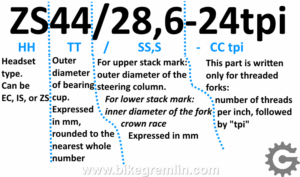
| External headset – EC | TABLE 1a | measures are in millimetres | |
| Legacy name | SHIS name | Cup outer diameter | Head tube inner diameter |
| 1″ JIS pressed cup | EC29 | 30 | 29.8 – 29.9 |
| 1″ Pro pressed cup | EC30 | 30.2 | 30 – 30.15 |
| 1″ BMX standard (old) | EC33 | 32.8 | 32.6 – 32.7 |
| 1-1/8″ pressed cup | EC34 | 34 | 33.8 – 33.95 |
| 1-1/4″ pressed cup | EC37 | 37 | 36.8 – 36.95 |
| External cup in the 44 standard | EC44 | 44.1 | 43.9 – 43.95 |
| 1-1/2″ pressed cup | EC49 | 49.7 | 49.55 – 49.6 |
| 1-1/2″ pressed cup | EC56 | 56 | 55.9 – 55.95 |
| Integrated headset – IS Relevant angles (separate article) | TABLE 1b | measures are in millimetres | |
| Legacy name | SHIS name | Bearing set outer diameter | Head tube inner diameter |
| 1″ IS (Cane Creek) | IS38 | 38 | 38.15 – 38.25 |
| 1-1/8″ IS (Cane Creek) | IS41 | 41 | 41.1 – 41.2 |
| 1-18″ Italian, Campagnolo hiddenset | IS42 | 41.8 | 41.95 – 42.05 |
| 1-1/4″ – only lower stack | IS47 | 47 | 47.05 – 47.1 |
| 1-3/8″ – only lower stack | IS49 | 49 | 49.1 – 49.2 |
| 1-1/2″ – only lower stack | IS52 | 52 | 52.1 – 52.15 |
| 1.8″ – only lower stack latest MTB and e-bike | IS58 | 58 | |
| Internal headset – ZS | TABLE 1c | measures are in millimetres | |
| Legacy name | SHIS name | Cup outer diameter | Head tube inner diameter |
| 1″ semi-integrated | ZS41 | 41.5 | 41.35 – 41.4 |
| 1-1/8″ semi-integrated | ZS44 | 44.1 | 43.9 – 43.95 |
| 1-1/2″ semi-integrated | ZS49 | 49.7 | 49.57 – 49.65 |
| 1-1/2″ semi-integrated (rare) | ZS55 | 55 | 54.9 – 54.95 |
| 1-1/2″ semi-integrated | ZS56 | 56 | 55.9 – 55.95 |
| 1.8″ semi-integrated latest MTB and e-bike | ZS58 | 58 |
Table 1: SHIS standard head tube inner diameters (and bearing cup outer diameters)
– marked as “TT” in picture 2.
3.2. Steering column outer diameter (in the upper part) – “SS,S-CCtpi”

| Upper part of the steering column outer diameter | TABLE 2 | measures are given in millimetres | |
| Legacy name | SHIS name | Steering column diameter in mm | For threaded forks – threads per inch |
| 1″ threadless | 25.4 | 25.4 | |
| 1-1/8″ threadless | 28.6 | 28.6 | |
| 1-1/4″ threadless | 31.8 | 31.8 | |
| 1-1/2″ threadless | 38.1 | 38.1 | |
| 1″ french standard threaded | 25.0-1.0pitch | 25 | 1 |
| 1″ threaded (BSC) | 25.4-24tpi | 25.4 | 24 |
| 1-1/8″ threaded | 28.6-26tpi | 28.6 | 26 |
| 1-1/4″ threaded | 31.8-26tpi | 31.8 | 26 |
Table 2: SHIS standard upper part of the steering column diameters – for the upper stack bearings
– marked as “SS,S-CCtpi” in picture 2.
3.3. Outer diameter of the fork crown (and fork crown race inner diameter) – “SS,S”
Since fork crown race is always pressed onto the fork crown, the race inner diameter is always smaller than the fork crown outer diameter.

| Fork crown (race) diameter | TABLE 3 | dimensions are given in mm | |
| Legacy name | SHIS name | Steering column diameter in mm | For threaded forks – threads per inch |
| 1″ Pro, or “Euro” standard | 26 | 26.5 | 26.4 |
| 1″ JIS | 27 | 27.1 | 27 |
| 1-1/8″ thread, or threadless | 30 | 30.1 | 30 |
| 1-1/4″ thread, or threadless | 33 | 33.1 | 33 |
| 1-1/2″ with pressed races | 40 | 39.8 | 39.7 |
| 1.8″ with pressed races latest MTB and e-bike | 45 | 45.1 | |
| 1-3/8″ integrated race | none | N/A | N/A |
Table 3: SHIS standard fork crown outer, and fork crown race inner diameters
– marked as “SS,S” in picture 2.
3.4. Dimension combos for tapered forks (and head tubes) – “upper_stack / lower_stack”
Tapered forks have the steering tube diameter that is wider in the lowest part, so the top and bottom bearing sets must differ in diameter. This overview of tapered fork standards will be sorted by the bearing type: first external (EC), then integrated (IS) and finally internal (ZS) bearing sets. With separate SHIS standard for upper and lower stack bearings. Some head tubes are made for a combination of ZS and EC bearings. These are noted under ZS parts (which kind of bearing is top and bottom is clear from the given full SHIS marks that denote the bearing type).

| External bearings (EC) – threaded forks | TABLE 4a | ||
| Legacy name | Upper stack bearing SHIS | Lower stack bearing SHIS | Notes |
| 1″ JIS | EC29/25.4-24tpi | EC29/27 | Common Asian standard |
| 1″ Pro/Euro | EC30/25.4-24tpi | EC30/26 | Standard threaded 1″ fork |
| 1″ BMX standard (old) | EC32/25.4-24tpi | EC32/26 | Older BMX standard – threaded and threadless |
| 1-1/8″ | EC34/28.6-26tpi | EC34/30 | |
| 1-1/4″ | EC37/31.8-26tpi | EC37/33 | |
| External bearings (EC) – threadless forks | TABLE 4b | ||
| Legacy name | Upper stack bearing SHIS | Lower stack bearing SHIS | Notes |
| 1″ JIS | EC29/25.4 | EC29/27 | Crown race is larger than with “Pro” standard |
| 1″ Pro/Euro | EC30/25.4 | EC30/26 | |
| 1-1/8″ | EC34/28.6 | EC34/30 | |
| 1-1/4″ | EC37/31.8 | EC37/33 | |
| 44 external cup | EC44/28.6 | EC44/30 | |
| 1-1/2″ | EC49/38.1 | EC49/40 | |
| 1-1/2″ reducer to 1-1/8″ | EC49/28.6 | EC49/30 | Reducer cups down to 1-1/8″ |
| 1-1/2″ – lower set only | N/A | EC56 | Lower set only |
| Integrated bearings (IS) – all threadless Relevant angles (separate article) | TABLE 4c | ||
| Legacy name | Upper stack bearing SHIS | Lower stack bearing SHIS | Notes |
| 1″ IS Cane Creek | IS38/25.4 | IS38/26 | Some triathlon bikes, not common |
| 1-1/8″ IS Cane Creek | IS41/28.6 | IS41/30 | “Cane Creek” standard |
| 1-1/8″ Italian Hiddenset | IS42/28.6 | IS42/30 | Campagnolo “Hiddenset” standard |
| 1-1/4″ lower set only | N/A | IS47/33 | |
| 1-3/8″ lower set only | N/A | IS49 | fork crown race is integrated into the fork |
| 1-1/2″ lower set only | N/A | IS52/40 | |
| 1.8″ lower set only | N/A | IS58/45 | |
| Internal bearings (ZS) – all threadless | TABLE 4d | ||
| Legacy name | Upper stack bearing SHIS | Lower stack bearing SHIS | Notes |
| 1″ | ZS41/25.4 | ZS41/26 | 1″ fork semi integrated – not common |
| 1-1/8″ | ZS44/28.6 | ZS44/30 | Common ZS headset |
| 1-1/2″ tapered | ZS49/28.6 | ZS49/40 | |
| Reducer for 1-1/2″ | ZS49/28.6 | ZS49/30 | Reducer to accept 28.6 mm steering column fork |
| Mixed standard | ZS49/28.6 | EC49/40 | |
| 1-1/2″ zero stack upper and lower | ZS49/38.1 | ZS49/40 | Full 1-1/2″ column with ZS headset |
| 1-1/2″ zero stack lower set | N/A | ZS55/40 | Only FSA models, obsolete |
| 1-1/2″ ZS lower set | N/A | ZS56/40 | |
| Mixed standard | ZS44/28.6 | EC49/30 | |
| ZS44/28.6 | ZS56/40 | ||
| Mixed standard | EC49/28.6 | ZS49/40 | |
| 1.8″ ZS lower set ZS58/45 |
Table 4: overview of SHIS standard bearing combinations for tapered forks
4. SHIS notation examples
A few examples will be given, to show how SHIS notation is used in practice.
Example 1:

A commonly used MTB headset has legacy name 1-1/8″ threadless. It uses external bearings (EC). A bicycle for this type of headset has the following measures:
Bearing cups outer diameter (marked as “TT” in picture 2) is 34 mm.
Head tube inner diameter (“TT” in picture 2) is 33.8 to 33.9 mm.
Steering column upper part outer diameter (“SS,S” in picture 2) is 28.6 mm that is 1-1/8″.
Fork crown race inner diameter (“SS,S” in picture 2) is 30 mm.
SHIS mark for this headset is: EC34/28.6 | EC34/30.
Any headset with the same SHIS mark will suit this bike.

Source: www.bike24.com
Picture 3
Example 2:

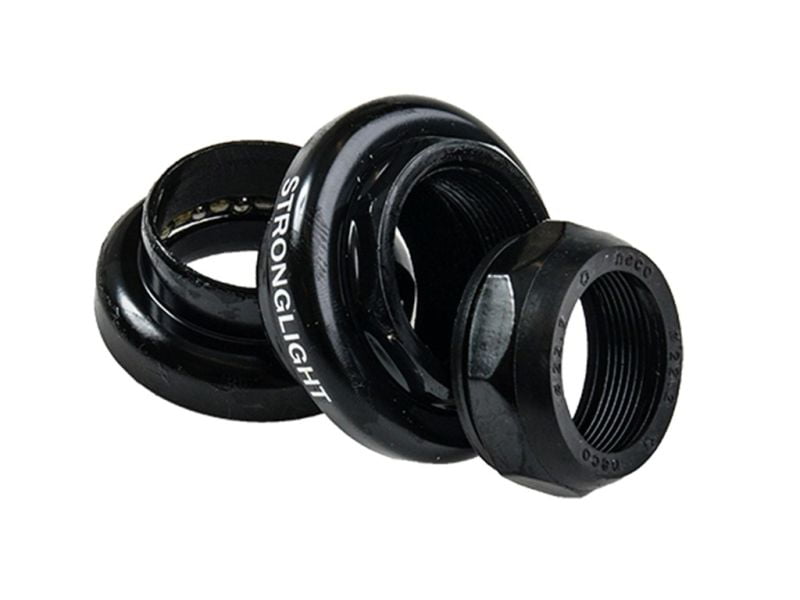
Source: www.cycleservicenordic.com
Picture 4
Common threaded bearing standard (less common on modern bicycles that have switched to threadless forks) is known as 1″ threaded, uses EC bearings and has the following dimensions:
Bearing cups outer diameter (marked as “TT” in picture 2) is 30.2 mm.
Head tube inner diameter (“TT” in picture 2) is 30 to 30.15 mm.
Steering column upper part outer diameter (“SS,S” in picture 2) is 25.4 mm, that is 1″, with 24 threads per inch.
Fork crown race inner diameter (“SS,S” in picture 2) is 26.4 mm – while fork crown outer diameter is 26.5 mm.
SHIS mark for this headset is: EC30/25.4-24tpi | EC30/26.
Example 3:

Integrated headset (IS).

Note how there are no cups (since the headset is integrated) and how lower bearing set has larger diameter than the top one.
Source: www.bike24.com
Picture 5
Headset in the picture 5 is for tapered forks and head tubes. Lower stack cup and fork crown race diameters are larger than for the top ones. Dimensions are the following:
Upper stack bearing outer diameter is 41.1 mm.
Head tube upper part inner diameter is 41.1 to 41.2 mm.
Steering column upper part outer diameter is 28.6 mm.
Lower stack bearing outer diameter is 52 mm.
Head tube lower part inner diameter is 52.1 to 52.15 mm.
Fork crown race inner diameter is 39.7 mm – while fork crown outer diameter is 39.8 mm.
SHIS mark for this headset is: ZS41/28.6 | ZS52/40
Example 4:


Note how lower bearing sat has larger outer diameter than the top one, but the inner diameter (not visible in the picture) is practically the same (for a fork with a uniform steering column diameter). Source: www.bike24.com
Picture 6
Headset in the picture 6 is for a tapered head tube and a fork with a uniform steering column diameter. The lower cup has a reducer from a wider head tube bore to a narrower steering column.
Upper stack bearing cup outer diameter is 44.1 mm.
Head tube upper part inner diameter is 43.9 to 43.95 mm.
Steering column upper part outer diameter is 28.6 mm.
Lower stack bearing cup outer diameter is 56 mm.
Head tube lower part inner diameter is 55.9 to 55.95 mm.
Fork crown race inner diameter is 30 mm – while fork crown outer diameter is 30.1 mm.
SHIS mark for this headset is: ZS44/28,6 | ZS56/30
Example 5 (universal approach):
- Measure inner diameter of the head tube upper bore (or the outer diameter of the top bearing cup, or bearing itself if it’s IS type) and find the matching SHIS measure from table 1a, b, or c – depending on bearing type (EC, IS, or ZS).
- Measure steering column upper section outer diameter and find the matching SHIS dimension in table 2.
- Then measure inner diameter of the head tube lower bore (or the outer diameter of the bottom bearing cup, or bearing itself if it’s IS type) and find the matching SHIS measure from table 1a, b, or c.
- Finally, measure fork crown outer diameter, or the inner diameter of the fork crown race and find the SHIS match in table 3.
5. Summary
SHIS nomenclature makes buying new headset bearings a lot easier, allowing for quick comparison of models from different manufacturers using a simple method: if SHIS marks are the same, the headset will fit. This enables purchase of separate top and lower stack bearings from different manufacturers, by just choosing proper upper and lower stack SHIS marks.
Short summary of SHIS nomenclature:

Headset types
Consists of two letters, noting the following:
EC: external headsets – sitting practically completely outside the head tube.
IS: integrated headsets – using head tube as a bearing cup – so they don’t come with cups.
ZS: internal headsets
Head tube diameter – upper part
A two digit whole number (no decimal).
Steering column diameter – upper part
Follows the upper head tube bore diameter, separated from it with a slash mark (” / “). Consists of a two digit number (plus one decimal).
Head tube diameter – lower part
Separated from the upper stack marks with an upright line (” | “). Two digit whole number.
Fork crown race diameter
Follows the lower head tube bore diameter, separated from it with a slash mark (” / “). Two digit whole number.
Stack height
Given separately for upper and lower bearing stack – this mark is optional and not commonly used. Format is: letter “H“, followed by stack height in millimetres.
Names of important headset parts are listed (with pictures) here:
01) Names of bicycle fork, head tube and headset parts
Instructions on how to measure all the important dimensions are given here:
02) Important fork, head tube and headset (bearing) dimensions
6. Exception – threaded fork standards
What is not included in the SHIS nomenclature is the steering column inner diameter. This is important for threaded forks, because there the stem is inserted into the steering column and fixed using a wedge on the inside.
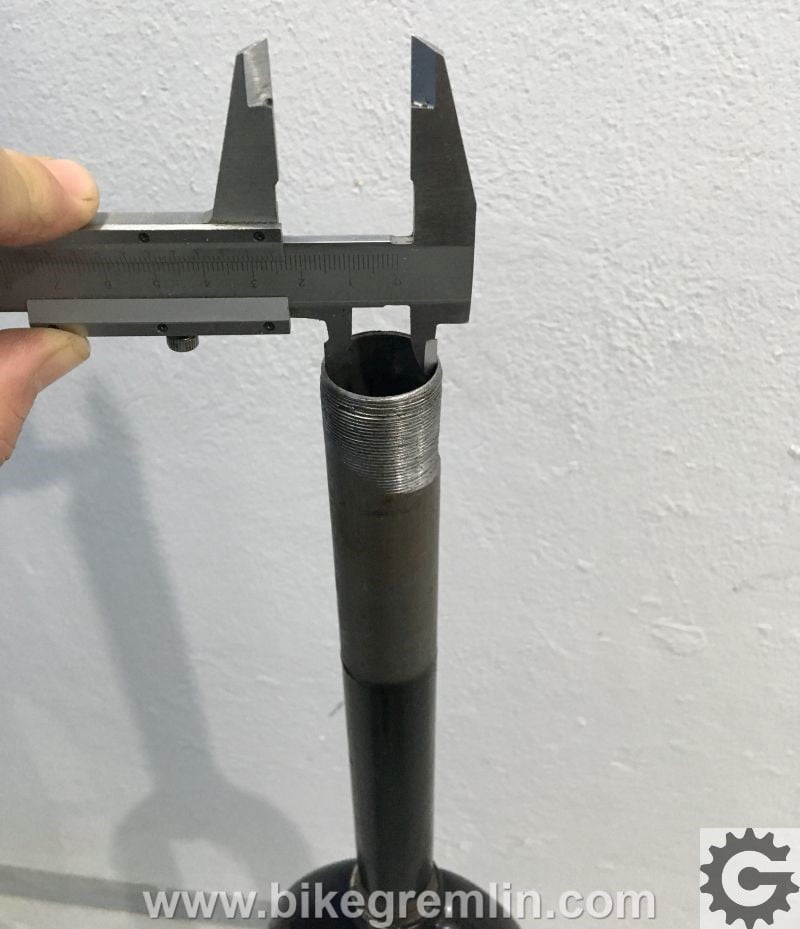
Picture 7
Dimension standards important for threaded forks (and matching stems) are given in this chapter in table 5.

| Threaded fork | TABLE 5 | measures are in millimetres | |
| Legacy name | Steering column outer diameter | Steering column inner diameter | Threads per inch |
| French | 25 | 22 | 25.4 |
| BMX | 25.4 (1″) | 21.15 | 24 |
| 1″ JIS | 25.4 | 22.2 | 24 |
| 1″ Pro, Campagnolo | 25.4 | 22.2 | 24 |
| 1″ ISO | 25.4 | 22.2 | 24 |
| 1″ Italian | 25.4 | 22.2 | 24 |
| Moulton | 25.4 | 22.2 | 24 |
| 1″ Raleigh | 25.4 | 22.2 | 26 |
| East German (DDR) | 26 | 22 | 26 |
| Austrian | 26 | 22 | 26 |
| 1-1/8″ | 28.6 (1-1/8″) | 25.4 (1″) | 26 |
| 1-1/4″ | 31.8 (1-1/4″) | 28.6 (1-1/8″) | 26 |
Table 5: Standard dimensions of threaded forks
Steering column outer diameter and thread TPI are included in SHIS nomenclature, only the inner diameter is omitted. So all the data except inner diameter can be found in tables 2 and 3.
7. Video – Headset cups measurement explanation and demonstration
Sources:
- Sheldon Brown – Bicycle headset dimension sheet
- ParkTool – Headset standards
- ParkTool – Standardized Headset Identification System
Last updated:
Originally published:

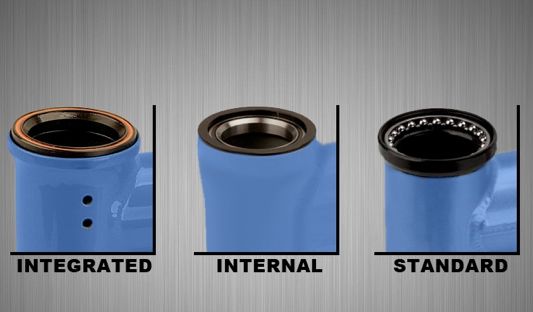
Hi, will a 1-1/8″ ZS44/28.6 ZS44/30 Common ZS bearings fit a frame with a headset of 44 external cup EC44/28.6 EC44/30?
Hi Alex,
That is a very good question. I should add that info to the article (note to self).
Until I get to a normal computer:
Yes, it will work.
However, you will probably need to add more spacers (ZS cups are not as tall as the EC cups).
Also, the bike’s geometry will get altered a bit – as the fork will end up about 0.5 to 1 cm closer to the bottom of the head tube (again, the thinner ZS cup).
That may result in a bit “quicker” steering and your saddle tilting a bit forward, with the seat tube getting a tad closer to vertical.
The changes up to 1 cm are not severe enough to cause steering problems, but can be noticed and you might need to adjust your fitting a bit.
See my article about bike frame geometry and forks for more details.
Again, the difference will most probably be too small to notice.
Frame geometry:
https://bike.bikegremlin.com/832/bicycle-frame-geometry/
Bicycle forks – the link should take you to the section with a few drawings which explain this particular scenario:
https://bike.bikegremlin.com/545/bicycle-fork/#3.3.3
Relja SmartphonesSuck Novović 🙂
Hi, I think you need to add that a 1 1/8″ crown diameter accepts a 30mm inner diameter crown race, a 1 1/4″ crown diameter accepts a 33mm crown race and a 1 1/2″ crown accepts a 40mm crown race.
I am only able to find one 44/30 crown race for the EC44/28.6 EC44/30 headset. https://www.johnatkinscycles.co.uk/product/101279/m-part-elite-crown-race-30mm-id-suits-ec44-ec49-lower-cup/option/.
Will this work with a ZS44/28.6 ZS44/30 headset?
Alex